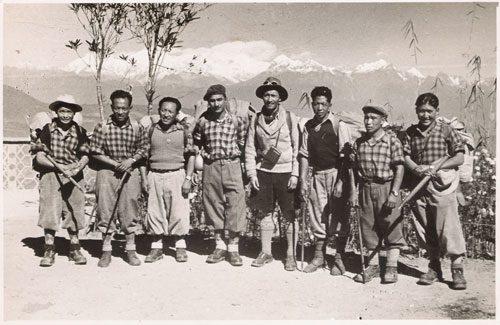|
saLT |
the-south-asian Life & Times July-Sep 2011 |
|
|||
|
Sports Tennis Feature Indian
Military Lt Gen R S Sujlana - A Conversation
Royals in
Uniform Art
Adventure 60
Years of Indian
Travel
|
|
||||
|
60 Years of Mountaineering in India By Nalni Jayal
On 23
June 1951, Gurdial Singh, Roy
Greenwood and Dawa Thondup reached the summit of Trisul, 23, 360 feet. It
was the first major summit by an Indian climber and it marked a watershed in
Indian climbing – an achievement by itself – and an inspiration to others
– the first achievement by an Indian
expedition on a major Himalayan peak.
Tenzing’s ascent of Everest two years later provided
a further and a tremendous boost to Indian climbing, and led to the setting
up of the Himalayan Mountaineering Institute (HMI) and the Indian
Mountaineering Foundation (IMF). Tenzing would have joined Gurdial on Trisul
had he not been booked by the French Nanda Devi expedition. Nandu Jayal (Nalni’s cousin) was also with the French
Nanda Devi expedition as liaison officer that year. The opulent
well-equipped French expedition and the shoe-string expedition of Gurdial,
found themselves camped together a couple of times on their way to and from
their respective mountains; the faithful Tenzing, evidently as good an
economist as a climber, ensured that some surplus French goodies found their
way to deficit areas. Trisul had been climbed by
Tom Longstaff in 1907. Gurdial’s achievement earned him the friendship of
Longstaff. The climbing of Trisul began a new chapter for Indian
mountaineering, but the wide world of mountaineering in the world was also
on the move. The fifties was the decade of the ‘Big Ones’. The first 8000m
had been climbed in 1950, Annapurna. Everest and Nanga Parbat in 1953, and
before the end of the decade, 13 of the world’s 14 peaks of over 8000m had
been climbed.
The 14th
was Shisha Pangma (Gosainthan), which was protected by its inaccessibility.
Read the entire article in the print copy of
|
|||||
|
Copyright © 2000 - 2011 [the-south-asian.com]. Intellectual Property. All rights reserved. |
|||||
